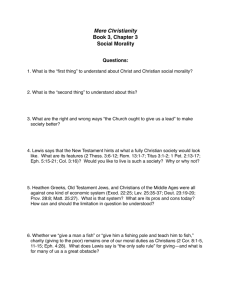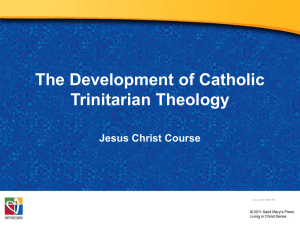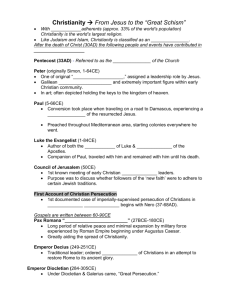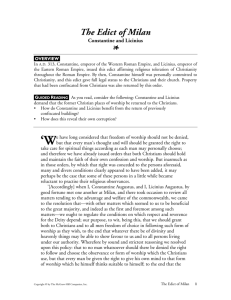Chapter 2: Persecution of “The Way” and Heresies
advertisement
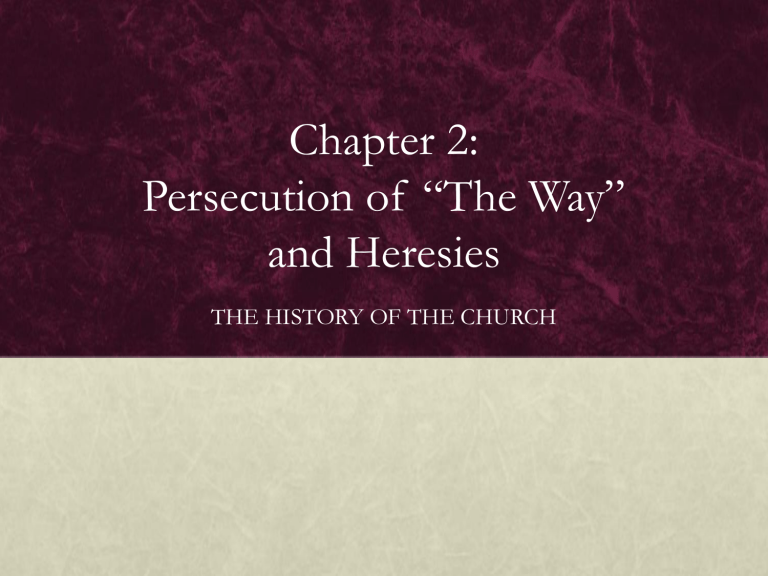
Chapter 2: Persecution of “The Way” and Heresies THE HISTORY OF THE CHURCH 1. Persecutions and the Five Good Emperors (pp. 46–54) ANTICIPATORY SET Analyze the mosaic on page 48, and then discuss the following questions: What does the mosaic depict? What does this mosaic reveal about the character of the Roman people? Is the depiction in this mosaic similar to anything in contemporary culture? 1. Persecutions and the Five Good Emperors (pp. 46–54) BASIC QUESTIONS What was the nature of the first Roman persecutions? How did the persecutions of the Christians develop after Domitian? KEY IDEAS Emperor Nero launched a brutal persecution of Christians, scapegoating them for the burning of Rome, for which he himself was rumored to have been responsible. Trajan’s Rescript delcared it a capital crime to profess Christianity. Hadrian’s Rescript advised that Christians should not be prosecuted for professing Christ, which was reversed under Marcus Aurelius. St. Justin Martyr defended Christianity to the Roman senate and emperor. 1. Persecutions and the Five Good Emperors (pp. 46–54) FOCUS QUESTIONS In the beginning, what did the Roman rulers consider the Christians to be? They considered the Christians to be a small sect of schismatic Jews. What actions show Nero’s evil character even before his persecution of Christians? He murdered his mother; renounced and slandered his wife before having her beheaded; and forced Seneca, the noble statesman, to commit suicide. 1. Persecutions and the Five Good Emperors (pp. 46–54) FOCUS QUESTIONS Why did Nero blame the Christians of Rome for the fire? Nero wanted to remove suspicion from himself. He arrested and tortured several Christians, extracted forced confessions from them, and then ordered a large number of Christians arrested. What did Nero do to Christians during the first persecution? This first persecution, which took place in the City of Rome, was brutal. Christians were sewn into animal skins so huge that hungry dogs would devour them. He had hundreds of live Christians coated with pitch and resin and burned as human torches to light his way as he passed through his gardens and along the streets at night. 1. Persecutions and the Five Good Emperors (pp. 46–54) FOCUS QUESTIONS How is Emperor Nero depicted in his sculpture with Seneca? Nero is portrayed as a youth, physically strong, handsome, and elegantly dressed. At the same time he is slouching in his throne and arrogantly looking down at Seneca, his teacher. Why is it thought Nero had set the fire that destroyed much of Rome? Nero intended to seize private property in the center of Rome to build himself a new palace. Nero was rumored to have set the fire to clear the buildings. 1. Persecutions and the Five Good Emperors (pp. 46–54) FOCUS QUESTIONS Why was it a good idea for dictators like Domitian to make friends with the army? In a dictatorship the armed forces ultimately have the power over life and death. He who controls the army controls the nation. What is the significance of the title Dominus et Deus with respect to Emperor Domitian? “Lord and God,” as he referred to himself, indicates he considered himself—or at least wanted others to consider him—a god. Why did Domitian see the spread of Christianity as a problem, and what steps did he take to stop it? Christianity was spreading from the lower classes to the aristocracy, Domitian’s own class. In response, he murdered his cousin, an office-holding Christian, and levied a 1. Persecutions and the Five Good Emperors (pp. 46–54) FOCUS QUESTIONS To what does vox populi refer? “The voice of the people” during the time of the early Church often meant ignorant actions undertaken by a mob of people, especially against Christians. Of what were Christians accused by the common people? Because they would not sacrifice to the pagan gods, Christians were accused of being irreligious and atheistic. Wild practices were attributed to Christians, including the sacrifice of babies, drinking their blood, and casting evil spells. What was the result of the power of the vox populi? Mobs looted and destroyed Christian churches, cemeteries, and homes. Civil authorities tortured and killed Christians to provide an outlet for the people’s anger. 1. Persecutions and the Five Good Emperors (pp. 46–54) FOCUS QUESTIONS What was Nero’s principle for dealing with Christians? Nero’s principle was Christiani non sunt: Let the Christians be exterminated. How is it known that Nero persecuted the Christians? It was reported by the Roman historian Tacitus and the Church historian Eusebius. What was Nero’s fate? The aristocracy in Rome was alienated by Nero’s murders of his mother and wife. After revolts against Roman rule broke out in Judea, Gaul, Africa, and Spain, the army turned against Nero, and he committed suicide. 1. Persecutions and the Five Good Emperors (pp. 46–54) FOCUS QUESTIONS Why were the “Five Good Emperors” called good? The five emperors following Domitian were good because they were skillful leaders of the empire. They were relatively stable people who secured the empire’s borders. Were the “Five Good Emperors” good for the Christians? The first four were more moderate toward Christians than Domitian had been, but they still persecuted them. Extension: Hadrian eradicated the Jews in the Holy Land. Why was Trajan a successful emperor from the Roman point of view? Trajan treated abandoned children and the poor humanely, achieved military glory for himself and Rome, undertook many public works projects, extended the territory of the empire, and ruled nearly twenty years. 1. Persecutions and the Five Good Emperors (pp. 46–54) GRAPHIC ORGANIZER Work with a partner to complete the following table about the content of Trajan’s Rescript. 1. Persecutions and the Five Good Emperors (pp. 46–54) 1. Persecutions and the Five Good Emperors (pp. 46–54) FOCUS QUESTIONS Why was St. Ignatius of Antioch an important writer? His direct contact with the Apostles Sts. Peter and John give his writings special authority. Who persecuted St. Ignatius of Antioch, and why? He was arrested under Emperor Trajan for being the Bishop of Antioch. Why did St. Ignatius of Antioch ask Christians not to intervene with the pagan officials when he was on his way to Rome? St. Ignatius was afraid the Christians of Rome might persuade the pagan officials to spare his life. He wanted to be God’s wheat, ground by the teeth of wild beasts, so he could be Christ’s pure bread. 1. Persecutions and the Five Good Emperors (pp. 46–54) FOCUS QUESTIONS How does Hadrian’s reign demonstrate that the Pax Romana did not manifest peace for everyone? The Jews were decimated in the Holy Land and were banned from entering Jerusalem. How did the plight of Christians improve somewhat after Hadrian’s Rescript? Hadrian ruled that mobs should not be able to take the law in their own hands to murder Christians, and Christians should only be prosecuted for actual violations of the common law instead of solely for being Christian. Why did Hadrian’s ban on circumcision and his plan to turn Jerusalem into a Roman colony infuriate the Jews? Circumcision is essential to the identity of Jews, the sign of the covenant between God and Abraham. Jerusalem had been the Jews’ most important city for a millennium; they had hoped to rebuild the Temple there so they could offer ritual sacrifice again. Extension: Hadrian could not have attacked the Jews more personally than this. 1. Persecutions and the Five Good Emperors (pp. 46–54) GUIDED EXERCISE When the governor offered to spare St. Polycarp’s life if he would curse Christ, the bishop replied, “Eighty and six years have I served him, and he never did me any injury: how then can I blaspheme my King and my Savior?” Search the Internet for a copy of Martyrium Polycarpi (“The Martyrdom of Polycarp”) and read it silently. 1. Persecutions and the Five Good Emperors (pp. 46–54) FOCUS QUESTIONS Under whose peaceful reign was St. Polycarp martyred? He was martyred under Emperor Antoninus Pius. What was the nature of St. Polycarp’s writings? He defended orthodox Catholic beliefs against several early heresies. What merciful offer did the governor of Smyrna make to St. Polycarp? If St. Polycarp would have cursed Christ publicly, his life would have been spared. 1. Persecutions and the Five Good Emperors (pp. 46–54) FOCUS QUESTIONS Of what philosophy was Emperor Marcus Aurelius an adherent? He was a Stoic, which encouraged one to live free of passion and unmoved by joy or grief, submitting fully to fate. What practice did Marcus Aurelius reinstate that made things worse for Christians? He reinstituted anonymous denunciations of Christians. Why did provincial governors tolerate mob attacks on Christians? For Roman governors serving in unruly provinces, allowing mob attacks on Christians was a way they could let people defuse their anger on something other than the empire itself. 1. Persecutions and the Five Good Emperors (pp. 46–54) FOCUS QUESTIONS What did St. Justin Martyr have in common with Emperor Marcus Aurelius? Both loved philosophy, although St. Justin came to believe the teachings of Christ were far superior to philosophy alone. To whom did St. Justin Martyr address his two defenses of the Faith? He addressed them audaciously to the Roman emperor and the senate. What did the judicial sentence Ad Metalla mean? This dreaded punishment sent a prisoner “to the metal mines,” where he endured brutal conditions and certain death. 1. Persecutions and the Five Good Emperors (pp. 46–54) CLOSURE Free write for five minutes summarizing the persecutions Christians experienced in the period of time after Emperor Domition through Emperor Marcus Aurelius. 1. Persecutions and the Five Good Emperors (pp. 46–54) HOMEWORK ASSIGNMENT Study Questions 1–5 (p. 90) Practical Exercise 1 (p. 91) Workbook Questions 1–30 Read “Later Persecutions and the Edict of Milan” through “The Edict of Milan” (pp. 55–60) 1. Persecutions and the Five Good Emperors (pp. 46–54) ALTERNATIVE ASSESSMENT Free write for five minutes on what was most surprising about this period in the history of the Church. 2. Later Persecutions and the Edict of Milan (pp. 55–61) ANTICIPATORY SET Imagine you are the bishop of an Italian diocese AD 202 and have received word that Emperor Severus has outlawed circumcision and Baptism. Write a brief letter to the Christians under your care, advising them how to respond to this decree. 2. Later Persecutions and the Edict of Milan (pp. 55–61) BASIC QUESTIONS How were persecutions under Diocletian the worst Christians had suffered under Roman emperors? Why was the Edict of Milan (AD 313) issued, and what change did it make in the lives of Christians? KEY IDEAS Persecutions under Diocletian were the worst Christians had endured because they were the most widespread and inclusive; Christians throughout the empire had either to renounce the Faith or to face death. Constantine attributed his victory at the Milvian Bridge to the intervention of the Christian God. To stay in his good graces, he issued the Edict of Milan, which gave the Christians the freedom to worship. 2. Later Persecutions and the Edict of Milan (pp. 55–61) FOCUS QUESTIONS Even though St. Irenæus was from Asia Minor, where did he serve as bishop? He served in Lyons in Gaul (modern-day France). Extension: This indicates the catholic (universal) nature of the Church. What key elements of the nature of the Church did St. Irenæus emphasize to defend the Faith against Gnostic heretics? He emphasized the episcopacy, Scripture, and Tradition. What method did St. Irenæus use to combat heresy? He described the origin and history of each heresy systematically, contrasting its false claims with true Faith. 2. Later Persecutions and the Edict of Milan (pp. 55–61) FOCUS QUESTIONS How did Decius attack Christians to a new degree? Before his reign attacks on Christians were local, either limited to the city of Rome or directed toward specific provinces. The Edict of Decius (AD 250) was empire-wide. Why did Decius order a return to the ancient religious practices? He intended to reinvigorate the empire’s strength by a unity of religious practice and belief. How numerous were Christians by AD 250, and why did Decius see them as a threat? About one-third of the empire was Christian. Decius assumed—because Christians’ ultimate allegiance is to Christ and not the state—that they might prove an obstacle to unify the empire. Extension: It may seem strange to a modern student a ruler would be willing to kill as many as one-third of his subjects, but similar events occurred in the twentieth century. Pol Pot of Cambodia, Mao of China, Lenin and Stalin of the Soviet Union, and many others killed large percentages of their populations for political ends. 2. Later Persecutions and the Edict of Milan (pp. 55–61) FOCUS QUESTIONS What strategy did Decius employ to identify Christians? Anyone who refused to offer a sacrifice would be sent into exile or put to death and lose all of his or her property. Who were the sacrificanti, the thurificati and the libellatici? These were Christians who had apostatized under Decius’ persecution. The sacrificanti were those who made a sacrifice. The thurificati were those who burned incense. The libellatici did not sacrifice but purchased certificates of sacrifice. What double loss did the Church suffer because of Decius’ persecution? The Church lost both those faithful who became martyrs and those who apostatized. 2. Later Persecutions and the Edict of Milan (pp. 55–61) FOCUS QUESTIONS Where was the first Catholic university founded? What might be called the first Catholic university was the Catechetical School in Alexandria, Egypt, in which instruction in Catholic doctrine was combined with an investigation into the sciences and philosophy. How was Origen distinguished? Origen was a prolific writer and scholar who headed the Catechetical School. He was faithful despite two years of imprisonment and torture. He initiated the use of the homily. How do Origen’s writings illustrate that individual theologians are not infallible? Despite being one the greatest theologians of the early Church, he held erroneous positions on the relationship between God the Father and God the Son and on the final salvation of the damned. 2. Later Persecutions and the Edict of Milan (pp. 55–61) GUIDED EXERCISE Think/Pair/Share using the following questions (cf. p. 57): According to St. Lawrence the deacon, what is the Church’s greatest treasure? Why might he have thought this? 2. Later Persecutions and the Edict of Milan (pp. 55–61) GRAPHIC ORGANIZER Work with a partner to complete the following table about Valerian’s Rescripts. 2. Later Persecutions and the Edict of Milan (pp. 55–61) 2. Later Persecutions and the Edict of Milan (pp. 55–61) FOCUS QUESTIONS How did Diocletian become emperor? Diocletian was named emperor by the army after Numerian was murdered. Why did the Church historian Eusebius initially praise Diocletian? Diocletian initially left Christians alone, but this was only because he was distracted by fighting the Persians and Germanic tribes. 2. Later Persecutions and the Edict of Milan (pp. 55–61) FOCUS QUESTIONS Why did Diocletian decide to eradicate Christianity? Though he admired some of its adherents, he decided to eradicate Christianity at the urging of two of his co-emperors, who argued it would be beneficial to the empire. Why was Diocletian’s persecution the worst the early Christians had suffered? It was the most widespread and targeted all Christians, especially in the eastern half of the empire, where few earlier persecutions had reached. What was the effect of Diocletian’s edicts? Thousands of faithful Christians were martyred. 2. Later Persecutions and the Edict of Milan (pp. 55–61) GRAPHIC ORGANIZER Complete the following table about the effects of Diocletian’s edicts on Christians in the Roman Empire. 2. Later Persecutions and the Edict of Milan (pp. 55–61) 2. Later Persecutions and the Edict of Milan (pp. 55–61) FOCUS QUESTIONS What was the effect of the Edict of Milan? It restored all property taken from the Church by the empire and granted Christians the right to worship in freedom. It legitimized the Church for the first time since Nero’s decree had outlawed her AD 64. What might have been the political motives for issuing the Edict of Milan? Constantine might have seen Christianity as a way to unify his empire. What did Constantine do at the end of his life? He was baptized (though by an Arian bishop) on his deathbed. 2. Later Persecutions and the Edict of Milan (pp. 55–61) CLOSURE Free write for five minutes framing an answer to the following question: Why did the Roman government attack Christianity with such vehemence? 2. Later Persecutions and the Edict of Milan (pp. 55–61) HOMEWORK ASSIGNMENT Study Questions 6–10 (p. 90) Practical Exercises 2–3 (p. 91) Workbook Questions 31–59 Read “Early Heresies” through “Docetism” (pp. 62–66) 2. Later Persecutions and the Edict of Milan (pp. 55–61) ALTERNATIVE ASSESSMENT Write a paragraph on a separate sheet of paper about the episcopacy and Tradition in the early Church. 3. Early Heresies (pp. 62–66) ANTICIPATORY SET Complete the following table contrasting common beliefs of the Gnostics with Christian doctrine. 3. Early Heresies (pp. 62–66) 3. Early Heresies (pp. 62–66) BASIC QUESTIONS What is heresy? Which doctrines did Gnostics, Marcionists, Manichæans, Montanists, and Docetists deny? KEY IDEAS Heresy is a post-baptismal, obstinate disbelief in one or more articles of the Faith. Gnosticism syncretizes Christian symbolism and bases salvation on secret knowledge. Marcionism creates a false dualism between law and love. Marcion identified the supposedly evil, vengeful God of the Law with the Gnostic Demiurge; he identified the Supreme Being as the good God of Love. Manichæism is a Gnostic, dualistic religion in which there are two equal gods: one good and the other evil. It holds that the world was created by Satan but secret knowledge and severe asceticism can bring salvation. Montanism holds that the arrival of the Kingdom of God is imminent and its leaders are inspired directly by the Holy Spirit. Docetism claims that God would never have become man and suffer such a degrading death, so someone else must have been substituted for Christ on the Cross. 3. Early Heresies (pp. 62–66) GRAPHIC ORGANIZER Complete the following table on four early heresies. 3. Early Heresies (pp. 62–66) 3. Early Heresies (pp. 62–66) FOCUS QUESTIONS What is the Deposit of Faith? The Deposit of Faith is the sum of all truths revealed in Sacred Scripture and Sacred Tradition; it is entrusted to the Church and interpreted infallibly by the Magisterium of the Church. Extension: It is the fullness of the Faith entrusted by Christ to the Apostles and their successors, the bishops. What is heresy, and what are its two kinds? Heresy is derived from the Deposit of Faith but denies or alters some part or parts of it. Material heresy occurs when a baptized person is ignorant about some aspect of the Faith, misunderstands it, or makes an erroneous judgment. Formal heresy occurs when a baptized person makes a free, conscious decision to deny some part of the Deposit of Faith. Why did the Greeks tend to look down on the material world, and how did it affect their acceptance of the Incarnation? Platonic philosophers viewed the material world as inferior to the world of ideas. Material entities were thought to be images of the world of ideas, with matter as an obstacle to contemplation and personal perfection. Thus, it would not have made sense in their minds for God, the perfect idea, to take on imperfect matter (a body). 3. Early Heresies (pp. 62–66) FOCUS QUESTIONS According to the Gnostics, what was wrong with Judaism? It was a false religion worshiping the evil Demiurge, mistakenly claiming that the world is good. What might a devout Jew think of Gnosticism? He or she would probably see Gnosticism as blasphemous. According to the Gnostics, who is the redeemer? Jesus, the Redeemer, was a good divine being whose mission was to bring secret knowledge to man. 3. Early Heresies (pp. 62–66) FOCUS QUESTIONS According to the Gnostics, why would it have been impossible for Christ to have taken on human nature? Since Jesus was a divine being, he could not have had a naturally evil human nature. What was the Crucifixion according to the Gnostics? Christ’s body was just an apparition; his spirit left his body before the Crucifixion. Why is Gnosticism basically pessimistic and Christianity basically optimistic? Gnostics see the world as evil with no way out for most people. Christians see creation as fundamentally good. Although sin entered the world through Adam 3. Early Heresies (pp. 62–66) FOCUS QUESTIONS What did Marcion think about Judaism? He rejected it as founded by the Gnostic evil Demiurge. What does it mean to call Marcionism dualistic? Marcionism put law and love in opposition. The Law was the work of the Demiurge, whereas love was preached by Jesus, the messenger of the good God. How did Marcion contribute to the formation of the canon of Sacred Scripture? Marcion rejected the Old Testament and most of the New Testament. This prompted the Church to define which books are inspired by the Holy Spirit. 3. Early Heresies (pp. 62–66) FOCUS QUESTIONS Out of what earlier heresy did Manichæism probably grow? It probably grew out of Gnosticism. According to the Manichees, what kind of cosmological battle is taking place? The universe is a battleground between Satan and God, darkness and light. Satan’s material world is wholly evil; he had stolen some light particles from God and placed them in the brains of humans. Manichæism promises a way to liberate that light through secret knowledge and rituals. Who was probably the most famous convert from Manichæism? St. Augustine was a Manichæan as a young man. 3. Early Heresies (pp. 62–66) GUIDED EXERCISE Work with a partner to write one-sentence definitions of Marcionism and Manichæism. 3. Early Heresies (pp. 62–66) FOCUS QUESTIONS Who was probably the most famous Montanist heretic? Tertullian was the most famous Montanist heretic. Why did the Montanists reject the authority of the Church? Montanus and his two female prophets, Prisca and Maximilla, claimed their authority came from the Holy Spirit directly. How were the Montanists stricter than the Church? They taught that Christians who had fallen from grace could never be redeemed. They rejected the possibility of forgiveness of sins after Baptism. 3. Early Heresies (pp. 62–66) FOCUS QUESTIONS What was the central tenet of Docetism? Jesus only appeared to be human and did not actually suffer the pain of Crucifixion and Death. Someone else, possibly Judas Iscariot or St. Simon of Cyrene, switched places miraculously with Christ just before the Crucifixion. How does Docetism destroy the central belief of Christianity that Jesus, the Christ, suffered and died for the forgiveness of our sins? If Christ did not suffer and die for us, then our sins are not forgiven and we are not redeemed. 3. Early Heresies (pp. 62–66) HOMEWORK ASSIGNMENT Study Questions 11–12 (p. 90) Practical Exercise 4 (p. 91) Workbook Questions 60–85 Read “The Ecumenical Councils” through “St. John Chrysostom, the Golden-mouthed” (pp. 67–72) 3. Early Heresies (pp. 62–66) ALTERNATIVE ASSESSMENT Using the completed Anticipatory Set on page 62, write a paragraph in response to the following question: What are some examples of Gnostic beliefs in modern-day culture? 4. Ecumenical Councils and Church Fathers (pp. 67–72) ANTICIPATORY SET Work with a partner to brainstorm reasons a Christian living in Antioch in Asia Minor AD 150 might have an advantage to understand the Scriptures over another person living in, say, Antioch, Illinois, in the twenty-first century. 4. Ecumenical Councils and Church Fathers (pp. 67–72) BASIC QUESTIONS What is the nature and function of an Ecumenical Council? What is a Father of the Church, and who were some of the most important? KEY IDEAS Twenty-one Ecumenical Councils have been held over the past 1700 years to define and defend the Faith, morals, and discipline of Catholicism. Father of the Church is a title given to great and holy leaders of the early Church who explained the Faith and fought heresy. Some of the most important were St. Ambrose of Milan, who defended the rights of the Church, even bending the wills of Roman emperors; the monk St. Jerome, who translated the Bible from its original languages into Latin; and the monk St. John Chrysostom, who, as Patriarch of Constantinople, clashed with the Empress Euodoxia, who persecuted him until his death. 4. Ecumenical Councils and Church Fathers (pp. 67–72) FOCUS QUESTIONS What is an Ecumenical Council? From the Greek oikoumene (“the whole [inhabited] world”), the Pope calls together bishops from around the world to discuss and decide matters of doctrine or discipline. What conditions must be met for the decisions of an Ecumenical Council to be infallible? When the bishops intend to define a matter of faith or morals and this is also the intention of and ratified by the Pope, the decision is infallible. When and where was the First Ecumenical Council held, and how many have there been? 4. Ecumenical Councils and Church Fathers (pp. 67–72) FOCUS QUESTIONS What is patristics? Patristics is the study of the Fathers of the Church and their writings. Extension: The word is derived from the Latin pater (“father”). What are four common characteristics of the Fathers of the Church? They were orthodox in doctrine, holy, had notoriety, and lived in the early centuries of the Church’s history. Why do the Church Fathers provide the standard for interpreting Scripture? Because of their proximity to the teachings of the Apostles, their clarification and interpretation of the Scriptures is a standard reference point for Church teaching. 4. Ecumenical Councils and Church Fathers (pp. 67–72) GRAPHIC ORGANIZER Complete the following table about St. Ambrose’s involvement in religious and political affairs. 4. Ecumenical Councils and Church Fathers (pp. 67–72) 4. Ecumenical Councils and Church Fathers (pp. 67–72) FOCUS QUESTIONS What was St. Ambrose’s background? He was from an important family, studied law, and was Bishop of Milan. What was St. Ambrose’s position in the Church when he was elected bishop? He was a catechumen. How did Emperor Theodosius demonstrate that he believed he had to answer to a law higher than himself ? Theodosius accepted St. Ambrose’s excommunication and requirement of performing public penance for his slaughter of 7000 Thessalonikans. 4. Ecumenical Councils and Church Fathers (pp. 67–72) FOCUS QUESTIONS What challenge is involved when translating any text, and why is it of particular importance for the Scriptures? The way ideas and issues are understood in one language—and in the age they were written—are generally not the same as in another. Accurate and faithful translations are important with respect to the Bible because people ground religious faith on these texts. What are some approved English translations of the Scriptures? The Douay-Rheims, the Jerusalem Bible, the New American Bible, the Revised Standard Version, and the New Revised Standard Version are approved by the Church, though this last one cannot be used in liturgical worship. Why is it believed the Vulgate might be the most faithful translation of the Bible? St. Jerome had access to early manuscripts in their original languages, most of which have been lost to history. 4. Ecumenical Councils and Church Fathers (pp. 67–72) GUIDED EXERCISE Review the section “Translations of the Bible” (pp. 71–72), and then complete a Think/Pair/Share using the following question: If you were to come across an English translation of the Bible, how could you determine if it is an approved translation? 4. Ecumenical Councils and Church Fathers (pp. 67–72) FOCUS QUESTIONS What is an Imprimatur? Latin for “let it be printed,” an Imprimatur is a declaration by a Catholic bishop that assures the reader that there is nothing in the published work contrary to the Catholic Faith or morals. What is the Greek meaning of canon? The Greek kanon means “reed,” or “measuring rod.” What is the canon of Scripture? The canon of Scripture refers to those books of the Old and New Testament which the Church declares to be part of Divine Revelation. 4. Ecumenical Councils and Church Fathers (pp. 67–72) FOCUS QUESTIONS What does “Chrysostom” mean, and why is it a moniker of St. John? Chrysostom means golden-mouthed; it refers to the richness of St. John’s preaching. What is the difference between cenobites and anchorites? Cenobites live in community, whereas anchorites live alone. St. John Chrysostom lived both kinds of monastic life before he was appointed Patriarch of Constantinople. What was St. John Chrysostom’s experience as bishop? Because he criticized the prevailing luxury and moral laxity—including the imperial court—he became the enemy of Empress Euodoxia, who exiled him twice. He eventually died because of a forced march and much suffering. 4. Ecumenical Councils and Church Fathers (pp. 67–72) CLOSURE Write one sentence each on Sts. Ambrose, Jerome, and John Chrysostom, summarizing what is most important about each. 4. Ecumenical Councils and Church Fathers (pp. 67–72) HOMEWORK ASSIGNMENT Study Questions 13–16 (p. 90) Practical Exercise 5 (p. 91) Workbook Questions 86–106 Read “Heresies of the Fourth and Fifth Centuries” through “Monothelitism” (pp. 73–81) 4. Ecumenical Councils and Church Fathers (pp. 67–72) ALTERNATIVE ASSESSMENT In groups of three or four, develop pictorial representations of Gnosticism, Marcionism, Manichaeism, Montanism, and Docetism. 5. Christological Heresies (pp. 73–81) ANTICIPATORY SET Mini-lecture on homoousios vs. homoiousios What is the difference between these two words? Homoousios means “of the same substance”; homoiousios means “of similar substance.” The difference between these two words is only one I (the Greek vowel iota). This iota had enormous importance in the struggle against the Arian heresy. The modern English usage of iota is a figurative term to refer to the very smallest part of something. Similarly, the phrase “not one iota of difference” is based historically on this controversy. 5. Christological Heresies (pp. 73–81) BASIC QUESTIONS What was the origin of some of the early Church heresies? What was the error of Arianism, and what central doctrines of the Faith were threatened by it? KEY IDEAS Heresies arose in the Church because of inaccurate interpretations of the Gospels and imprecise philosophical definitions. Arians taught that Jesus was of a similar substance to God the Father but an inferior creature. This rejection of his divinity threatened especially the doctrines of the Trinity and the Redemption. 5. Christological Heresies (pp. 73–81) FOCUS QUESTIONS Why is Arianism a Christological heresy? Arius’ central error had to do with the natures of Christ. What did Arius teach about the natures of Christ? Arius taught that Christ was God’s highest creature, through whom God created the universe. How did the Athanasian Creed explain Christ’s equality and inferiority to God the Father? The Athanasian Creed teaches that Christ “is equal to the Father in his divinity but inferior to the Father in his humanity.” 5. Christological Heresies (pp. 73–81) FOCUS QUESTIONS What did Arius’s teaching about Christ threaten to do to the Church’s teachings on the Blessed Trinity and Christ’s Redemption? It threatened to destroy them. Were God the Son a creature, the doctrine of the Blessed Trinity is false. If Christ is not God, God did not take on human nature and could not have redeemed all of us who have a human nature. Who led the fight against the Arian heresy? St. Athanasius never gave up despite five times being exiled. Why was the First Ecumenical Council a particularly august gathering of bishops? Many bishops bore physical scars suffered under Diocletian’s persecution. 5. Christological Heresies (pp. 73–81) GUIDED EXERCISE Write one sentence stating the essential difference between Arianism and Catholicism. 5. Christological Heresies (pp. 73–81) GRAPHIC ORGANIZER Work with a partner to complete the following table about Greek vocabulary and the Arian heresy. 5. Christological Heresies (pp. 73–81) 5. Christological Heresies (pp. 73–81) GUIDED EXERCISE Discuss the philosophical and theological principles that form the basis for the Church’s understanding of the Person and natures of Christ. 5. Christological Heresies (pp. 73–81) FOCUS QUESTIONS Why did the Pope not attend the First Ecumenical Council of Nicæa, and how did he make his opinion known? Pope St. Sylvester I was old and too infirm to travel. He sent two priests as his legates. What do the words homoousios and consubstantialis mean? They mean “of the same essence,” or “substance,” in Greek and Latin, respectively. What does homoousios mean with respect to the relationship between the Son and the Father? It means the Son and the Father are of the same essence. They are equally God. 5. Christological Heresies (pp. 73–81) GUIDED EXERCISE Discuss the following question: Some people argue the Catholic Church was invented by Emperor Constantine. How does the rise of Arianism disprove this claim? 5. Christological Heresies (pp. 73–81) FOCUS QUESTIONS Why did Emperor Constantine send Arius into exile and later recall him? Constantine used his political power to enforce his will. When the Council of Nicæa declared that Christ is of the same essence as the Father, Constantine exiled Arius and two bishops who rejected the orthodox teaching. Three years later, Constantine changed his mind, recalled Arius, and began to persecute the orthodox bishops. Why was Arius not installed as the Patriarch of Constantinople? Constantine decided Arius’s position would become the orthodox one and appointed him to be the Patriarch of Constantinople. Arius died before he could be installed. How did emperors and Arian bishops force Arianism on the Church? Bishops were threatened with and, in cases, experienced exile, torture, and death. 5. Christological Heresies (pp. 73–81) FOCUS QUESTIONS How did St. Athanasius defend the orthodox teaching against Arianism? St. Athanasius defended orthodoxy through years of writing against Arianism and supporting the Nicene Creed. What is the Nicene Creed? The Nicene Creed is the profession of faith made by the Council Fathers at the close of the First Ecumenical Council of Nicæa. It was expanded during the First Ecumenical Council of Constantinople, which reaffirmed the orthodox Faith after the death of Emperor Constantius. (This expanded profession of faith, professed at Mass, is called properly the Niceno-Constantinopolitan Creed, but it is called popularly the Nicene Creed.) Both Creeds are statements of fundamental Catholic beliefs, especially regarding the nature of God and the Person and natures of Christ. Why is the exact wording of a creed so important? The exact wording is important because of theological complexity, opposition to heresy, historical continuity, and the unity it provides. 5. Christological Heresies (pp. 73–81) FOCUS QUESTIONS Why is St. Hilary of Poitiers called the Athanasius of the West? St. Hilary was the preeminent defender of orthodoxy against Arianism in the western half of the empire just as St. Athanasius had been in the eastern half of the empire. If you were a heretic, would you be open to talking to someone like St. Hilary? Probably so; St. Hilary’s method was not only to condemn heresy but also to reconcile his opponent to the Church by showing how at least some of their disagreements were merely a matter of semantics and the ideas were actually the same. 5. Christological Heresies (pp. 73–81) FOCUS QUESTIONS What Marian doctrine did St. Gregory of Nyssa defend? He defended the popular title Theotokos, Greek for “Bearer of God.” What is the core error of Apollinarianism? Reacting to Arius, Apollinarus taught Christ had a human body but not a human soul (no human intellect or will). 5. Christological Heresies (pp. 73–81) GUIDED EXERCISE Get into groups of three or four and rewrite the NicenoConstantinopolitan Creed (p. 76) as an Arian document. Then discuss the following questions: What have you deleted? What have you changed? What have you added? 5. Christological Heresies (pp. 73–81) FOCUS QUESTIONS What did St. Basil the Great do to strengthen the priesthood? He had the priests of his diocese trained rigorously and properly. What did St. Basil the Great do for the sick and the poor? He set up a system of hospitals and social service institutions for them. 5. Christological Heresies (pp. 73–81) GRAPHIC ORGANIZER Complete the following table about four more early heresies. 5. Christological Heresies (pp. 73–81) 5. Christological Heresies (pp. 73–81) FOCUS QUESTIONS What is the core error of Nestorianism? Nestorius incorrectly taught that Christ is a union of two persons, one human and one divine. Why did his Christological error lead Nestorius to reject the title Theotokos? If Christ were two persons, then the Blessed Virgin Mary would not be the Mother of the divine Person, the Theotokos; she must be the mother of the human person only. Extension: Nestorians accepted the title Christotokos to describe the Blessed Virgin Mary. 5. Christological Heresies (pp. 73–81) FOCUS QUESTIONS Though a creature, why does the Church call the Blessed Virgin Mary the Mother of God? Jesus Christ, her Son, is one Person with two natures. Mothers give birth to Persons, not natures. Therefore, the Blessed Virgin Mary is the Mother of the Person of Jesus Christ, who is a divine Person. This does not mean that she preexists God in some way. What was the result of Nestorius’ refusal to recant his heretical teaching? The Third Ecumenical Council (Ephesus, AD 431) condemned Nestorius’ teachings and affirmed that the Blessed Virgin Mary is the Theotokos. Extension: Declaring the Blessed Virgin Mary to be the Mother of God is an affirmation of the Personhood of Christ. 5. Christological Heresies (pp. 73–81) GUIDED EXERCISE Work with a partner to list the accomplishments of Pope St. Leo the Great. 5. Christological Heresies (pp. 73–81) FOCUS QUESTIONS What is the Ecthesis, and what was its fate along with Pope Honorius? Pope Honorius replied to a letter from the Patriarch of Constantinople, who was attempting to reconcile with the Monophysites. Pope Honorius agreed with his teaching of one will. The patriarch then quoted the Pope in the Ecthesis, the official document of Monothelitism. The next three Popes condemned the Ecthesis, as did the Fathers of the Sixth Ecumenical Council, who also anathematized Pope Honorius. Why do some cite Honorius’s use of “one will” as an argument against fallibility? He made an erroneous statement of faith, which was quoted by another bishop, that later Popes and an Ecumenical Council condemned. Why does the case of Honorius not disprove papal infallibility? He did not intend to define a matter of faith or morals for the universal Church. Statements made in private correspondence do not fit the criteria for infallibility. 5. Christological Heresies (pp. 73–81) FOCUS QUESTIONS What is the core error of Monophysitism? In a reaction to Nestorianism, Monophysites taught that Christ has only one nature, his human nature having been absorbed into his divine nature. This denies Christ is true man. What did the Council Fathers mean when they siad, “Peter has spoken through Leo”? At the Fourth Ecumenical Council (Chalcedon, AD 451), Pope St. Leo I’s legates spoke first and presented his Tome—a treatise against Monophysitism—which was accepted as the orthodox position. This phrase witnesses to Christ having built his Church upon the rock of St. Peter and that the Bishop of Rome is his successor. 5. Christological Heresies (pp. 73–81) FOCUS QUESTIONS What is the core error of Monothelitism? Monothelites taught that Christ has two natures but one (divine) will; he lacks a human will. Who first taught the Monothelite heresy, and why? Emperor Heraclius developed it in an effort to reconcile Monophysites with the Church. The Christians of Asia Minor and Palestine were at odds with each other over Monophysitism, and Heraclius wanted to unify them so they would work together to defeat the Persian military threat. 5. Christological Heresies (pp. 73–81) HOMEWORK ASSIGNMENT Study Questions 17–21 (p. 90) Workbook Questions 107–134 Read “Dogmatic and Sacramental Heresies” through “Conclusion” (pp. 81–86) 5. Christological Heresies (pp. 73–81) CLOSURE Free write for five minutes in response to the following prompt: Compare and contrast the relationship between Emperor Nero and Christians of the first century with Emperor Constantine and Christians of the fourth century. 5. Christological Heresies (pp. 73–81) ALTERNATIVE ASSESSMENT Open workbook quiz using a question from last night’s homework. 6. Dogmatic and Sacramental Heresies and the Official Religion (pp. 81–86) ANTICIPATORY SET Complete the following table about Donatism and Pelagianism. 6. Dogmatic and Sacramental Heresies and the Official Religion (pp. 81–86) 6. Dogmatic and Sacramental Heresies and the Official Religion (pp. 81–86) BASIC QUESTIONS What are the core errors of the Donatist and Pelagian heresies? How did Chrisitianity become the official religion of the Roman Empire? KEY IDEAS Two heresies attacked the Sacraments of the Church: Donatists taught that sinful ministers could not celebrate the Sacraments validly, and Pelagianists taught that people can be saved without grace, thereby making the Sacraments unnecessary. Despite an interruption during the reign of Julian the Apostate, Christianity was granted increasing benefits during the fourth century until Theodosius made Christianity the official religion of the empire. 6. Dogmatic and Sacramental Heresies and the Official Religion (pp. 81–86) FOCUS QUESTIONS What is the core error of Pelagianism? Pelagianists taught that people can be redeemed and sanctified without grace. This denies the implications of the Fall and Original Sin. Why are Donatism and Pelagianism both dogmatic and sacramental heresies? They deny dogmatic teachings about the forgiveness of sins and Original Sin, respectively. Both affect the Sacraments: Donatists denied that grave sinners can be valid ministers of the Sacraments, and Pelagianists denied the necessity of the Sacraments. 6. Dogmatic and Sacramental Heresies and the Official Religion (pp. 81–86) FOCUS QUESTIONS What is the core error of Donatism? Donatists taught that grave sinners cannot repent and be reunited to the Church. In addition, sinful priests and bishops are incapable of administering the Sacraments validly. What was St. Augustine’s answer to the Donatists? The true minister of every Sacrament is Christ, even if the earthly minister of the Sacrament is in a state of mortal sin. 6. Dogmatic and Sacramental Heresies and the Official Religion (pp. 81–86) GUIDED EXERCISE Do a focused reading on the paragraph, “Though St. Augustine was born…” (p. 83), using the following question: In what ways did the world seem to be falling apart at the end of St. Augustine’s life? 6. Dogmatic and Sacramental Heresies and the Official Religion (pp. 81–86) FOCUS QUESTIONS What are some examples of the disordered life St. Augustine lived as a young man? He was attracted by both lust and heresy. He had a concubine with whom he had a son out of wedlock. He became a member of the heretical Manichæan sect. What lesson did St. Augustine learn when he reflected on his experience stealing pears? He realized he was attracted to doing something wrong simply because it was wrong. This prompted him to realize that people have an inclination to rebel against God. 6. Dogmatic and Sacramental Heresies and the Official Religion (pp. 81–86) FOCUS QUESTIONS For what is St. Augustine’s mother famous? St. Monica prayed for her son’s conversion for many years. How did St. Augustine’s conversion come about? St. Augustine lost his faith in Manichæism and was moved by the preaching of St. Ambrose of Milan. One day he heard a young boy singing, “Tolle et lege” (“take and read”), and he picked up the Scriptures, opened it, and found a passage that spoke exactly to his situation in life. He decided to convert and abandon his sinful ways. What are St. Augustine’s two most important books, and what are they about? His Confessions is the first psychological autobiography ever written. City of God contrasts the imperfect “City of Man” with the perfect “City of God.” 6. Dogmatic and Sacramental Heresies and the Official Religion (pp. 81–86) GUIDED EXERCISE Work with a partner to review the section in this chapter about St. Ambrose of Milan (p. 70). Answer the following question: How did St. Ambrose show the Western political leaders that he did not believe in caesaropapism? 6. Dogmatic and Sacramental Heresies and the Official Religion (pp. 81–86) FOCUS QUESTIONS In the East what tended to be the relationship between the throne and altar? The altar tended to be subservient to the throne. What is caesaropapism? This expresses the situation that tended to be the norm in the East. The emperor as head of the state directed many affairs of the Church. For example, the emperor often selected the Patriarch of Constantinople. 6. Dogmatic and Sacramental Heresies and the Official Religion (pp. 81–86) FOCUS QUESTIONS What good things did Emperor Constantine do for Christians and the Church? Licinius, with whom Constantine ruled the empire, started a persecution of Christians, but Constantine defeated him in battle, making religious toleration possible throughout the empire. Constantine freed priests and churches from taxation, permitted individual churches to receive donations, forbade work on Sunday, ended crucifixion as a form of execution, and did not attend pagan rites. What shift in the power center of the Roman Empire did Constantine create? He moved the capital of the empire from Rome to Constantinople AD 330. This resulted in a shift of economic, cultural, and linguistic power to the East. What were some effects of the move of the capital on the Western Church? Greek became the language of government; at the same time, the ability to read and write Greek was on the decline in the West. The West began to appear backward and poor compared to the East. 6. Dogmatic and Sacramental Heresies and the Official Religion (pp. 81–86) GRAPHIC ORGANIZER Work with a partner to complete the following table, giving three responses in favor and three against the following question: Was Constantine a Christian? 6. Dogmatic and Sacramental Heresies and the Official Religion (pp. 81–86) 6. Dogmatic and Sacramental Heresies and the Official Religion (pp. 81–86) FOCUS QUESTIONS Why was Emperor Julian called “the Apostate”? Though baptized, he worked to reestablish paganism on an equal footing with Christianity and strip Christians of the special benefits Constantine and his successors had granted them. When Emperor Julian organized his new pagan church, what model did he use? He developed a liturgical and sacramental system modeled on the Church’s. What was the aftermath of Emperor Julian’s death? Succeeding emperors reduced paganism to oblivion and returned to Christianity the rights he had taken from it. 6. Dogmatic and Sacramental Heresies and the Official Religion (pp. 81–86) GUIDED EXERCISE Read the following excerpt from one of Emperor Julian’s letters: “These impious Galileans not only feed their own poor, but ours also; welcoming them into their agape, they attract them, as children are attracted, with cakes.” “Whilst the pagan priests neglect the poor, the hated Galileans devote themselves to works of charity, and by a display of false compassion have established and given effect to their pernicious errors. See their love-feasts, and their tables spread for the indigent.” “Such practice is common among them, and causes a contempt for our gods.” Discuss the following questions: What do these passages reveal about fourth century Christian practices? What do these passages reveal about Emperor Julian’s bias against Christianity? 6. Dogmatic and Sacramental Heresies and the Official Religion (pp. 81–86) FOCUS QUESTIONS How did Emperor Theodosius I cement the relationship between Church and state? He made Christianity the official religion of the Roman Empire. What were some of the practical results of having Christianity as the official religion of the empire? Heresy became a legal offense. Pagan practices were outlawed. The most powerful effect was the union of throne and altar. How did the Church survive the numerous heresies of the fourth and fifth centuries? The Church survived due to the leadership of her Popes, the Fathers of the 6. Dogmatic and Sacramental Heresies and the Official Religion (pp. 81–86) CLOSURE Free write for five minutes in response to the following question: What are some strengths and drawbacks to the state supporting one religion over others? 6. Dogmatic and Sacramental Heresies and the Official Religion (pp. 81– 86) HOMEWORK ASSIGNMENT Study Questions 22–25 (p. 90) Practical Exercise 6 (p. 91) Workbook Questions 135–151 6. Dogmatic and Sacramental Heresies and the Official Religion (pp. 81–86) ALTERNATIVE ASSESSMENT Write a paragraph above one of the five examples of the union of throne and altar. THE END

